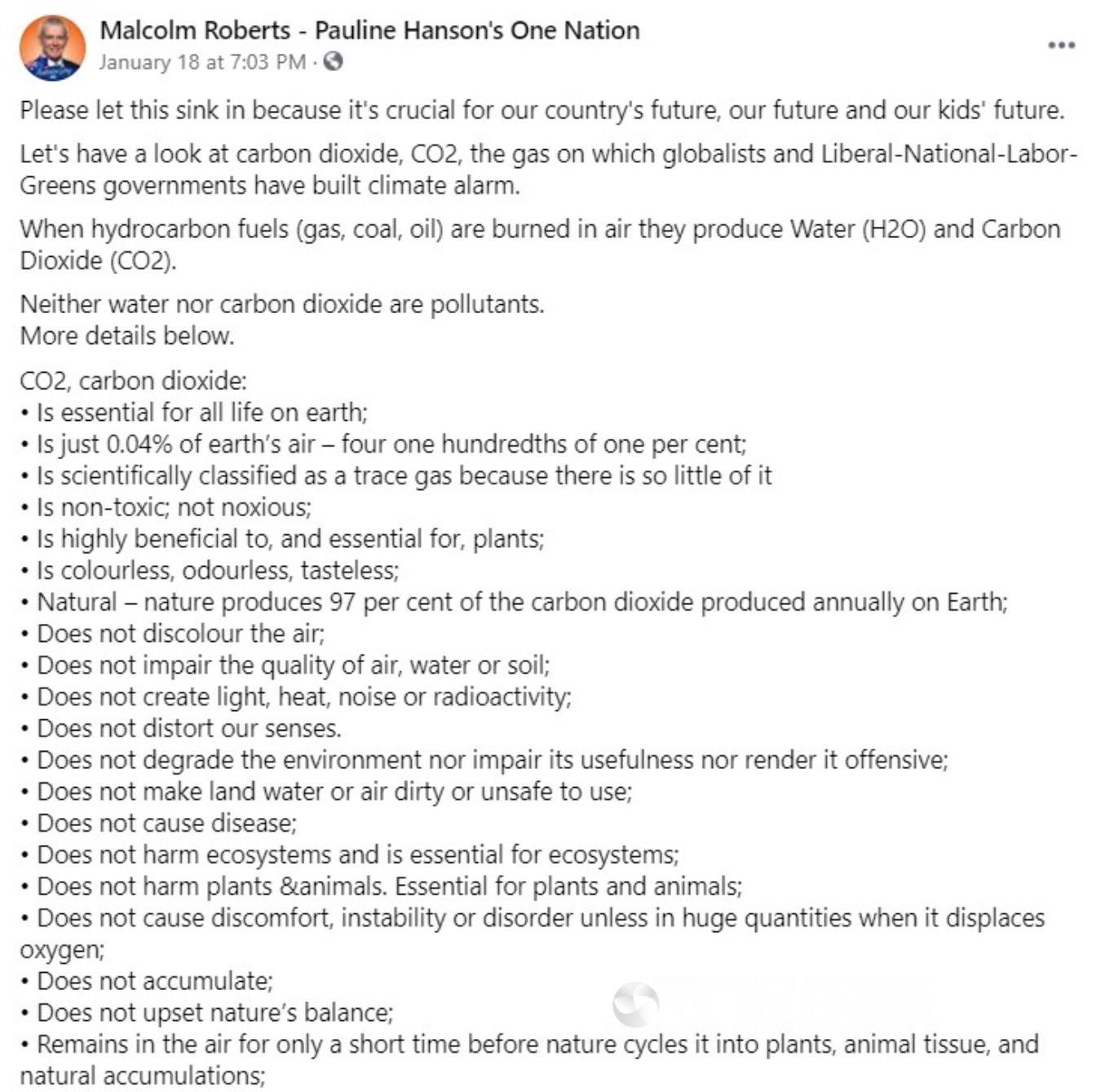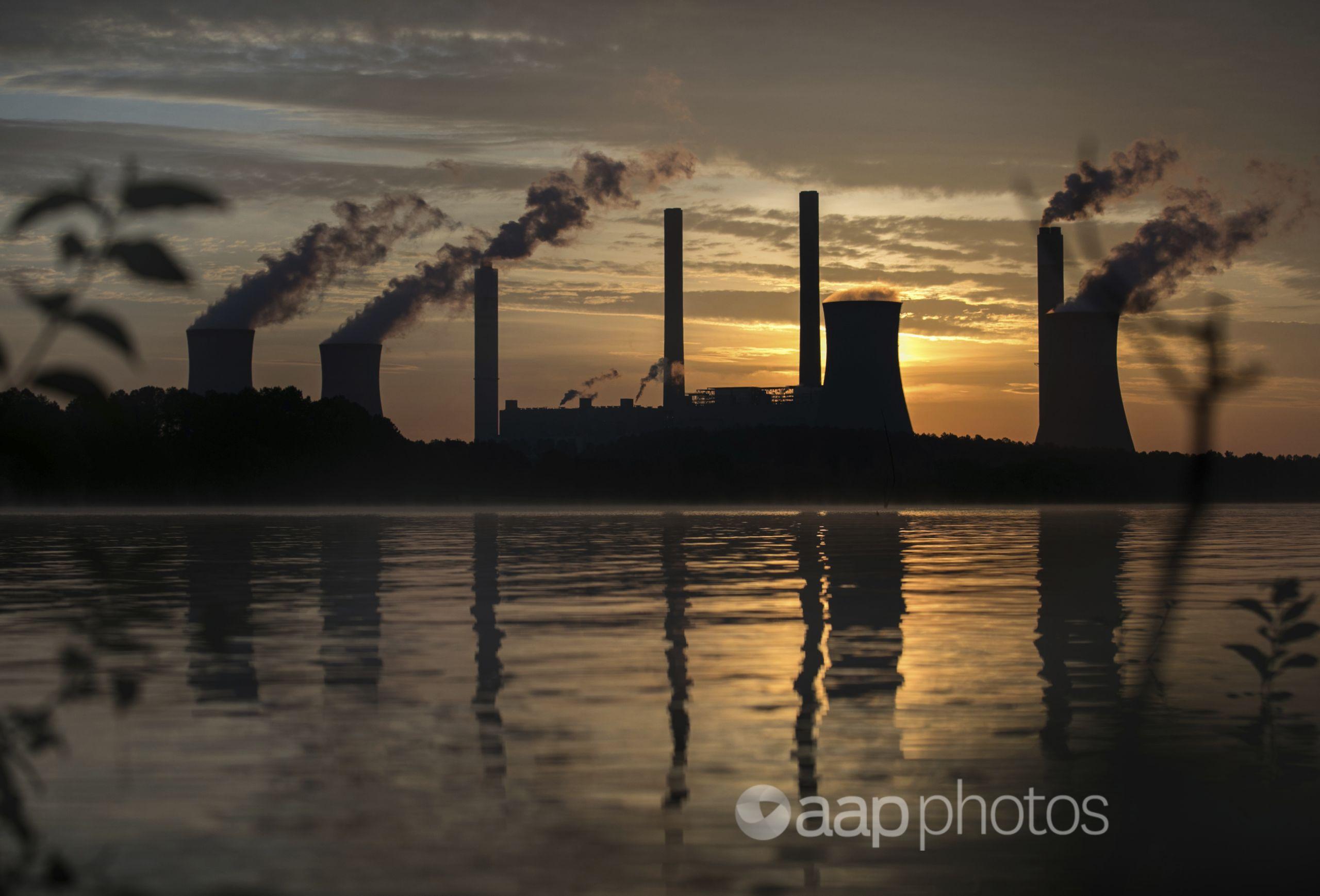The Statement
Australian senator Malcolm Roberts has claimed that nature – not mankind – is solely responsible for the levels of carbon dioxide (CO2) in the atmosphere.
In a lengthy Facebook post on January 18 to his more than 64,000 followers, the One Nation representative made a range of unsourced claims disputing that CO2 was a pollutant.
“Nature alone controls the level of CO2 in earth’s air,” Mr Roberts’ post said. “Empirical scientific data proves this.”
Mr Roberts has long denied humans are causing climate change and has advanced various conspiracy theories relating to global warming.

The Analysis
Decades of scientific study into the level and make-up of atmospheric CO2 has shown that man-made emissions from burning fossil fuels have been rapidly accumulating and causing the planet to warm, in contradiction of Mr Roberts’ claims.
The One Nation senator’s office did not respond to emails from AAP FactCheck asking for the basis of his statement.
The latest figures from NASA showed atmospheric CO2 levels had reached 415 parts per million (ppm) in December 2020, the highest level in at least 800,000 years.
Direct measurements of CO2 levels are collected from sites such as the Mauna Loa Observatory in Hawaii, which has the longest record with measurements dating back to 1958. Dozens of sites around the world, including in Australia and New Zealand, collate regular readings.
Earlier records of CO2 levels have been developed from ice cores, which contain bubbles of air trapped in ice providing a record dating back 800,000 years.
Together, these records show a marked increase in CO2 levels in the atmosphere since industrialisation, with the current concentration of the gas around 38 per cent higher than its previous pre-industrial peak.
University of New South Wales climate scientist and professor Matthew England said Mr Roberts’ statement was “totally false”.
“It’s as false as saying the Earth is flat or that pigs fly backwards,” Prof England said.
“We can precisely measure the amount of carbon dioxide in the atmosphere due to human activity, it is irrefutable. The natural pre-industrial level was 280ppm. Today it is over 400ppm due to human activity.
“That’s the highest it’s been for at least the last 800,000 years. It’s basic physics and chemistry.”
An article on the US National Oceanic and Atmospheric Administration (NOAA) website said that over the past 60 years CO2 levels had increased about 100 times faster than during previous natural increases, and this was “mostly because of the fossil fuels that people are burning for energy”.
It described CO2, which warms the Earth by absorbing and radiating heat, as the most important, long-lived greenhouse gas as it was more abundant and stayed in the atmosphere longer than other gases such as methane or nitrous oxide.
Because of this, CO2 was responsible for “about two-thirds of the total energy imbalance that is causing Earth’s temperature to rise”.
On its website, the Intergovernmental Panel on Climate Change (IPCC) says natural planetary cycles could not explain the large increases in atmospheric CO2.
“Emissions of CO2 from fossil fuel combustion, with contributions from cement manufacture, are responsible for more than 75 per cent of the increase in atmospheric CO2 concentration since pre-industrial times,” it says.
“The remainder of the increase comes from land use changes dominated by deforestation (and associated biomass burning) with contributions from changing agricultural practices. All these increases are caused by human activity.”
Victoria University of Wellington professor Martin Manning, who has contributed to IPCC reports, said claims such as those from Mr Roberts had been rebutted multiple times.
“This is ignoring the multiple lines of evidence from ice cores and tree rings that the atmospheric level of CO2 was quite stable for thousands of years after the last ice age ended,” he said.
“But then (it) increased rapidly over the last 200 years at the same time as the industrial revolution led to increasing use of fossil fuels. Natural processes continue, but we add to them and have pushed the global carbon cycle out of equilibrium.”
An article on NASA’s Earth Observatory website explained how the clearing of forests and burning of fossil fuels has put the carbon cycle out of balance.
“So far, land plants and the ocean have taken up about 55 per cent of the extra carbon people have put into the atmosphere while about 45 per cent has stayed in the atmosphere,” it said.
“Eventually, the land and oceans will take up most of the extra carbon dioxide, but as much as 20 per cent may remain in the atmosphere for many thousands of years.”
Prof Manning said research applying radiocarbon dating to CO2 was developed in the 1950s and this showed increased CO2 largely came from burning fossil fuels as the carbon in the atmosphere was getting “older” each year.
“This was because the added carbon was coming from fossil sources, so the added carbon was about 600 million years older than what is in the atmosphere naturally,” he said.
The NOAA explains that CO2 from fossil fuels, which are millions of years old, does not contain the isotope carbon-14 as it decays over time.
However, carbon emitted naturally from “young sources” – such as forests and oceans – does contain carbon-14, making it possible to use the isotope to gauge the extent to which humans are contributing to the level of CO2 in the atmosphere.
A decline in the proportion of the isotope carbon-13 in the atmosphere has also been linked to the increase in CO2 from burning fossil fuels.
CSIRO Climate Science Centre chief research scientist and Global Carbon Project executive director Pep Canadell said nature has a large impact on the amount of CO2 in the atmosphere, but natural carbon sinks, such as oceans and forests, can’t keep up with the amount of CO2 humans are producing by burning fossil fuels.
“If one day we were to decide to stop emitting CO2, nature would take care and move all that excess CO2 in the atmosphere into various compartments of the Earth,” Dr Canadell said.
“The sting in the tail is that it would take tens of thousands of years for nature to do so – 1,000 years to remove 80 per cent, and then tens of thousands to remove the rest – not too helpful for the next unprecedented bushfire season or round of heatwaves.”

The Verdict
AAP FactCheck found the statement that nature alone controls the level of CO2 in the atmosphere to be false.
Monitoring stations and ice core records have shown that CO2 levels have been increasing in the atmosphere over the past century at a far faster rate than during historic cycles. The carbon make-up of the gas shows it has primarily come from the burning of fossil fuels.
Climate scientists say natural cycles do regulate the natural absorption and emission of carbon, however this process has been put out of balance due to human-induced CO2 emissions, leading to global warming.
False – Content that has no basis in fact.
* Editor’s note: AAP FactCheck has expanded its ability to fact-check environmental issues with the support of the Australian Conservation Foundation. AAP FactCheck retains full editorial independence in this project and continues to apply the rigorous standards required for accredited members of the International Fact-Checking Network.
All information, text and images included on the AAP Websites is for personal use only and may not be re-written, copied, re-sold or re-distributed, framed, linked, shared onto social media or otherwise used whether for compensation of any kind or not, unless you have the prior written permission of AAP. For more information, please refer to our standard terms and conditions.

















